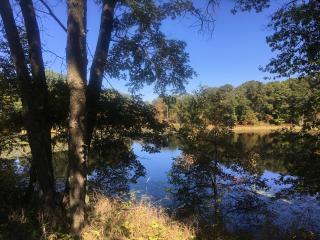Projects showcase Forest Legacy Program’s versatility
WISCONSIN—With a goal to keep forests as forests, the USDA Forest Service’s Forest Legacy Program embraces a wide spectrum of conservation possibilities, exemplified by two recent Eastern Region projects— one helping to create a brand-new state forest in New York and another, supporting private forest owners in protecting small but ecologically important tracts of land in Minnesota.

The Forest Legacy Program provides grants to support state projects that permanently protect forestland at risk of being converted to non-forest uses. These projects can range from purchasing large tracts of forest that will be managed as public land to protecting smaller family-owned private forestland with perpetual conservation easements.
With the help of FLP funding, the New York Department of Environmental Conservation Division of Lands and Forests recently completed the Rensselaer Plateau Working Forest project, resulting in the acquisition of 5,548 acres of forestland in Rensselaer County that will be managed as part of the new Cowee State Forest.
A decade or so in the making, this project will help ensure a reliable supply of forest products supporting the regional economy, as well as provide an impressive array of public outdoor recreational opportunities. At the same time, it will protect important ecological communities and habitat for a wide range of both common and imperiled plant and animal species.
The Rensselaer Plateau Working Forest project would not have been possible without the DEC’s strong partnership with the Rensselaer Plateau Alliance (now known as Hudson Taconic Lands) and with The Conservation Fund — a national nonprofit land conservation organization that frequently works with state agencies and the Forest Service to help develop and implement successful FLP projects.
“Conserving public lands is critical to protecting drinking water, enhancing biodiversity, increasing access and creating opportunities for New Yorkers to get outside, all while supporting the sustainability of the local wood products economy,” said Gov. Kathy Hochul. “Working with land trusts and other valued partners, New York State is continuing to expand our footprint on the beautiful Rensselaer Plateau, preserving and improving public lands for future use and enjoyment.”
In the Minnesota project, fewer acres were conserved but the impact has been just as significant. Located in Morrison County and the culmination of a multi-year effort by the Minnesota Department of Natural Resources Division of Forestry, the Camp Ripley Sentinel Landscape FLP project involved five private landowners whose forested properties are near the Minnesota National Guard’s 53,000-acre Camp Ripley training facility. The individual properties together equal 997 acres that are now permanently protected under conservation easements held by the state.
Bob Perleberg, who owns one of the protected tracts, sees this project as part of an important tradition of conservation. “Hindsight has shown the great conservation heroes of the United States — Teddy Roosevelt, John Muir, Henry Thoreau and Aldo Leopold — were correct in their vision to preserve the wild places of America,” he said. “The work they started must be continued to maintain the quality of the environment, the protection of wildlife habitat and to ensure proper forest management. The FLP has helped us to ensure our ownership will be protected and managed in a way that meets our goals as landowners far into the future.”

The five tracts range in size from 111 to 458 acres and are located within one of the most culturally and biologically rich landscapes in the Midwest. The extensive network of rivers, lakes and interspersed forestland helps provide clean drinking water for over 1.5 million people. The project adds to the network of other land protection programs and partners conserving land surrounding Camp Ripley.
“This project is of high importance to the area and to our state,” said Patty Thielen, Minnesota State Forester. “It allows us to work with landowners and other partners to protect unique forest communities and habitats, continue to provide economic benefits from sustainable forest management and protect critical drinking water sources. We appreciate the assistance we receive in Minnesota from our federal partners, and the Forest Legacy Program is a great example of that.”
The Forest Service’s FLP serves as a model for cooperative conservation in the Eastern Region and throughout the United States and its territories. Since 1990, the FLP has permanently conserved over 3 million acres of forestland, which can be further explored using the Forest Legacy Interactive Map.
